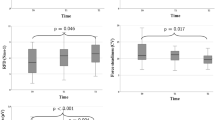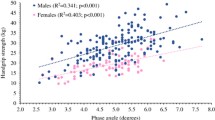Abstract
Background
Despite the widespread application of measurements of respiratory muscle force (PImax) in clinical trials there is no data on biological variation, reference change value (RCV), or the minimal important difference (MID) for PImax irrespective of the target cohort. We addressed this issue for patients with chronic stable heart failure.
Methods and results
From the outpatients’ clinic of the University of Heidelberg we retrospectively selected three groups of patients with stable systolic chronic heart failure (CHF). Each group had two measurements of PImax: 90 days apart in Group A (n = 25), 180 days apart in Group B (n = 93), and 365 days apart in Group C (n = 184). Stability was defined as (a) no change in NYHA class between visits and (b) absence of cardiac decompensation 3 months prior, during, and 3 months after measurements. For each group, we determined within-subject (CVI), between-subject (CVG), and total (CVT) coefficient of variation (CV), the index of individuality (II), RCV, reliability coefficient, and MID of PImax. CVT was 8.7, 7.5, and 6.9 % for groups A, B, and C, respectively. The II and RCV were 0.21, 0.20, 0.16 and 13.6, 11.6, 10.8 %, respectively. The reliability coefficient and MID were 0.83, 0.87, 0.88 and 1.44, 1.06, 1.12 kPa, respectively. Results were similar between age, gender, and aetiology subgroups.
Conclusion
In patients with stable CHF, measurements of PImax are highly stable for intervals up to 1 year. The low values for II suggest that evaluation of change in PImax should be performed on an individual (per patient) basis. Individually significant change can be assumed beyond 14 % (RCV) or 1.12 kPa (MID).


Similar content being viewed by others
References
Hammond MD, Bauer KA, Sharp JT, Rocha RD (1990) Respiratory muscle strength in congestive heart failure. Chest 98(5):1091–1094
Mancini DM, Henson D, LaManca J, Levine S (1992) Respiratory muscle function and dyspnea in patients with chronic congestive heart failure. Circulation 86(3):909–918
Meyer FJ, Zugck C, Haass M, Otterspoor L, Strasser RH, Kubler W, Borst MM (2000) Inefficient ventilation and reduced respiratory muscle capacity in congestive heart failure. Basic Res Cardiol 95(4):333–342
Witt C, Borges AC, Haake H, Reindl I, Kleber FX, Baumann G (1997) Respiratory muscle weakness and normal ventilatory drive in dilative cardiomyopathy. Eur Heart J 18(8):1322–1328
Mancini DM, Henson D, LaManca J, Levine S (1994) Evidence of reduced respiratory muscle endurance in patients with heart failure. J Am Coll Cardiol 24(4):972–981
Walsh JT, Andrews R, Johnson P, Phillips L, Cowley AJ, Kinnear WJ (1996) Inspiratory muscle endurance in patients with chronic heart failure. Heart 76(4):332–336
Vincken W, Ghezzo H, Cosio MG (1987) Maximal static respiratory pressures in adults: normal values and their relationship to determinants of respiratory function. Bulletin Euro de PhysiopatholRes 23(5):435–439
Ambrosino N, Opasich C, Crotti P, Cobelli F, Tavazzi L, Rampulla C (1994) Breathing pattern, ventilatory drive and respiratory muscle strength in patients with chronic heart failure. Euro Respir J Off J Euro Soc Clin Respir Physiol 7(1):17–22
Filusch A, Ewert R, Altesellmeier M, Zugck C, Hetzer R, Borst MM, Katus HA, Meyer FJ (2011) Respiratory muscle dysfunction in congestive heart failure–the role of pulmonary hypertension. Int J Cardiol 150(2):182–185. doi:10.1016/j.ijcard.2010.04.006
Nishimura Y, Maeda H, Tanaka K, Nakamura H, Hashimoto Y, Yokoyama M (1994) Respiratory muscle strength and hemodynamics in chronic heart failure. Chest 105(2):355–359
Ribeiro JP, Chiappa GR, Callegaro CC (2012) The contribution of inspiratory muscles function to exercise limitation in heart failure: pathophysiological mechanisms. Revista brasileira de fisioterapia 16(4):261–267
Ribeiro JP, Chiappa GR, Neder JA, Frankenstein L (2009) Respiratory muscle function and exercise intolerance in heart failure. Curr Heart Failure Reports 6(2):95–101
Frankenstein L, Nelles M, Meyer FJ, Sigg C, Schellberg D, Remppis BA, Katus HA, Zugck C (2009) Validity, prognostic value and optimal cutoff of respiratory muscle strength in patients with chronic heart failure changes with beta-blocker treatment. Euro J Cardiovasc Prev Rehabil Off J Euro Soc Cardiol Working Groups Epidemiol Prev Cardiac Rehabil Exerc Physiol 16(4):424–429. doi:10.1097/HJR.0b013e3283030a7e
Meyer FJ, Borst MM, Zugck C, Kirschke A, Schellberg D, Kubler W, Haass M (2001) Respiratory muscle dysfunction in congestive heart failure: clinical correlation and prognostic significance. Circulation 103(17):2153–2158
Chiappa GR, Roseguini BT, Vieira PJ, Alves CN, Tavares A, Winkelmann ER, Ferlin EL, Stein R, Ribeiro JP (2008) Inspiratory muscle training improves blood flow to resting and exercising limbs in patients with chronic heart failure. J Am Coll Cardiol 51(17):1663–1671. doi:10.1016/j.jacc.2007.12.045
Dall’Ago P, Chiappa GR, Guths H, Stein R, Ribeiro JP (2006) Inspiratory muscle training in patients with heart failure and inspiratory muscle weakness: a randomized trial. J Am Coll Cardiol 47(4):757–763. doi:10.1016/j.jacc.2005.09.052
Jaenisch RB, Hentschke VS, Quagliotto E, Cavinato PR, Schmeing LA, Xavier LL, Dal Lago P (2011) Respiratory muscle training improves hemodynamics, autonomic function, baroreceptor sensitivity, and respiratory mechanics in rats with heart failure. J Appl Physiol 111(6):1664–1670. doi:10.1152/japplphysiol.01245.2010
Johnson PH, Cowley AJ, Kinnear WJ (1998) A randomized controlled trial of inspiratory muscle training in stable chronic heart failure. Eur Heart J 19(8):1249–1253
Laoutaris I, Dritsas A, Brown MD, Manginas A, Alivizatos PA, Cokkinos DV (2004) Inspiratory muscle training using an incremental endurance test alleviates dyspnea and improves functional status in patients with chronic heart failure. Euro J Cardiovasc Prev Rehabil Off J Euro Soc Cardiol Working Groups Epidemiol Prev Cardiac Rehabil Exerc Physiol 11(6):489–496
Laoutaris ID, Adamopoulos S, Manginas A, Panagiotakos DB, Kallistratos MS, Doulaptsis C, Kouloubinis A, Voudris V, Pavlides G, Cokkinos DV, Dritsas A (2013) Benefits of combined aerobic/resistance/inspiratory training in patients with chronic heart failure. A complete exercise model? A prospective randomised study. Int J Cardiol 167(5):1967–1972. doi:10.1016/j.ijcard.2012.05.019
Laoutaris ID, Dritsas A, Adamopoulos S, Manginas A, Gouziouta A, Kallistratos MS, Koulopoulou M, Voudris V, Cokkinos DV, Sfirakis P (2011) Benefits of physical training on exercise capacity, inspiratory muscle function, and quality of life in patients with ventricular assist devices long-term postimplantation. Euro J Cardiovasc Prev Rehabil Off J Euro Soc Cardiol Working Groups Epidemiol Prev Cardiac Rehabil Exerc Physiol 18(1):33–40. doi:10.1097/HJR.0b013e32833c0320
Laoutaris ID, Dritsas A, Brown MD, Manginas A, Kallistratos MS, Chaidaroglou A, Degiannis D, Alivizatos PA, Cokkinos DV (2008) Effects of inspiratory muscle training on autonomic activity, endothelial vasodilator function, and N-terminal pro-brain natriuretic peptide levels in chronic heart failure. J Cardiopulm Rehabil Prev 28(2):99–106. doi:10.1097/01.HCR.0000314203.09676.b9
Mancini DM, Henson D, La Manca J, Donchez L, Levine S (1995) Benefit of selective respiratory muscle training on exercise capacity in patients with chronic congestive heart failure. Circulation 91(2):320–329
McConnell TR, Mandak JS, Sykes JS, Fesniak H, Dasgupta H (2003) Exercise training for heart failure patients improves respiratory muscle endurance, exercise tolerance, breathlessness, and quality of life. J Cardpulm Rehabil 23(1):10–16
Stein R, Chiappa GR, Guths H, Dall’Ago P, Ribeiro JP (2009) Inspiratory muscle training improves oxygen uptake efficiency slope in patients with chronic heart failure. J Cardiopulm Rehabil Prev 29(6):392–395. doi:10.1097/HCR.0b013e3181b4cc41
Tabet JY, Meurin P, Driss AB, Weber H, Renaud N, Grosdemouge A, Beauvais F, Cohen-Solal A (2009) Benefits of exercise training in chronic heart failure. Arch Cardiovasc Dis 102(10):721–730. doi:10.1016/j.acvd.2009.05.011
Weiner P, Waizman J, Magadle R, Berar-Yanay N, Pelled B (1999) The effect of specific inspiratory muscle training on the sensation of dyspnea and exercise tolerance in patients with congestive heart failure. Clin Cardiol 22(11):727–732
Winkelmann ER, Chiappa GR, Lima CO, Viecili PR, Stein R, Ribeiro JP (2009) Addition of inspiratory muscle training to aerobic training improves cardiorespiratory responses to exercise in patients with heart failure and inspiratory muscle weakness. Am Heart J 158 (5):768e761–768e767. doi:10.1016/j.ahj.2009.09.005
Hunt SA, American College of C, American Heart Association Task Force on Practice G (2005) ACC/AHA 2005 guideline update for the diagnosis and management of chronic heart failure in the adult: a report of the American College of Cardiology/American Heart Association Task Force on Practice Guidelines (Writing Committee to Update the 2001 Guidelines for the Evaluation and Management of Heart Failure). J Am Coll Cardiol 46(6):e1–e82. doi:10.1016/j.jacc.2005.08.022
McMurray JJ, Adamopoulos S, Anker SD, Auricchio A, Bohm M, Dickstein K, Falk V, Filippatos G, Fonseca C, Gomez-Sanchez MA, Jaarsma T, Kober L, Lip GY, Maggioni AP, Parkhomenko A, Pieske BM, Popescu BA, Ronnevik PK, Rutten FH, Schwitter J, Seferovic P, Stepinska J, Trindade PT, Voors AA, Zannad F, Zeiher A, Guidelines ESCCfP (2012) ESC Guidelines for the diagnosis and treatment of acute and chronic heart failure 2012: The task force for the diagnosis and treatment of acute and chronic heart failure 2012 of the European Society of Cardiology. Developed in collaboration with the Heart Failure Association (HFA) of the ESC. Euro Heart J 33(14):1787–1847. doi:10.1093/eurheartj/ehs104
Wen AS, Woo MS, Keens TG (1997) How many maneuvers are required to measure maximal inspiratory pressure accurately. Chest 111(3):802–807
Harik-Khan RI, Wise RA, Fozard JL (1998) Determinants of maximal inspiratory pressure. The Baltimore longitudinal study of aging. Am J Respir Crit Care Med 158(5 Pt 1):1459–1464. doi:10.1164/ajrccm.158.5.9712006
Fraser CG, Harris EK (1989) Generation and application of data on biological variation in clinical chemistry. Crit Rev Clin Lab Sci 27(5):409–437. doi:10.3109/10408368909106595
Iglesias N, Petersen PH, Ricos C (2005) Power function of the reference change value in relation to cut-off points, reference intervals and index of individuality. Clin Chem Lab Med CCLM/FESCC 43(4):441–448. doi:10.1515/CCLM.2005.078
Wyrwich KW, Nienaber NA, Tierney WM, Wolinsky FD (1999) Linking clinical relevance and statistical significance in evaluating intra-individual changes in health-related quality of life. Med Care 37(5):469–478
Wyrwich KW, Tierney WM, Wolinsky FD (1999) Further evidence supporting an SEM-based criterion for identifying meaningful intra-individual changes in health-related quality of life. J Clin Epidemiol 52(9):861–873
Wells G, Beaton D, Shea B, Boers M, Simon L, Strand V, Brooks P, Tugwell P (2001) Minimal clinically important differences: review of methods. J Rheumatol 28(2):406–412
Bland JM, Altman DG (1986) Statistical methods for assessing agreement between two methods of clinical measurement. Lancet 1(8476):307–310
Fraser CG (2001) Changes in serial results. In: Fraser CG (ed) Biological variation: from principles to practice. AACC Press, Washington, pp 67–90
Ricós C, Perich C, Minchinela J, Álvarez V, Simón M, Biosca C, Doménech M, Fernández P, Jiménez CV, Garcia-Lario JV, Cava F (2009) Application of biological variation—a review. Biochem Med 19(3):250–259. doi:10.11613/BM.2009.023
Schunemann HJ, Guyatt GH (2005) Commentary–goodbye M(C)ID! Hello MID, where do you come from? Health Serv Res 40(2):593–597. doi:10.1111/j.1475-6773.2005.00374.x
Beaton DE, Boers M, Wells GA (2002) Many faces of the minimal clinically important difference (MCID): a literature review and directions for future research. Curr Opin Rheumatol 14(2):109–114
Conflict of interest
None declared.
Author information
Authors and Affiliations
Corresponding author
Rights and permissions
About this article
Cite this article
Täger, T., Schell, M., Cebola, R. et al. Biological variation, reference change value (RCV) and minimal important difference (MID) of inspiratory muscle strength (PImax) in patients with stable chronic heart failure. Clin Res Cardiol 104, 822–830 (2015). https://doi.org/10.1007/s00392-015-0850-3
Received:
Accepted:
Published:
Issue Date:
DOI: https://doi.org/10.1007/s00392-015-0850-3




